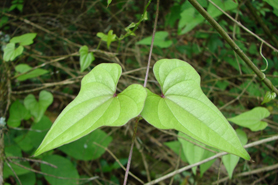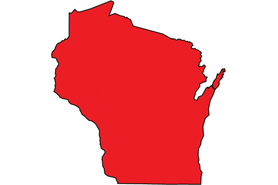Chinese yam; Indian yam
(Dioscorea polystachya, D. batatas); (D. oppositifolia)
Herbaceous perennial vines with large underground tubers and aerial bulbils. Plants can grow up to 15’ long. It twines counterclockwise and the petioles and stems are purple-red.
Other names for this plant include:
- Common names: Cinnamon vine, Japanese mountain yam, Korean yam
Classification in Wisconsin: Prohibited
- Ecological Threat
-
- Invades stream banks, other riparian areas, mesic forests, roadways, fence rows, and drainage ways.
- Rapid, early growth allows the vine to block out sunlight and shade out native plants. It forms dense mats that can down branches and kill trees. Native ground cover is also displaced and shaded out, unable to penetrate the blanket of vines.
- Spreads rapidly via aerial bulbils, a potentially long distance from the parent plant.
- Identification
-
Leaves: Leaves are generally opposite but maybe alternate in upper nodes. They are spear to oval-shaped (or heart-shaped), coming to a sharp point. There are 1.5-3” long and up to 1.5” wide with 7-9 parallel leaf veins. Newly emerged leaves are tinted bronze; mature leaves have purple-red leaf edges and petioles.
Flowers: In leaf axils, greenish-white flowers bloom on spikes during June-September, producing a cinnamon fragrance.
Fruits & seeds: Aerial bulbils, small potato-like tubers, are produced in leaf axils during June-September. Gravity, animals and water spread them and they can germinate within two weeks of forming. Bulbils are covered with adventitious buds that can produce new plants if damaged.
Roots: Large vertical tubers, up to 3’ long, are produced and can resprout if the entire root is not removed.
Similar species: Native wild yam (Dioscorea villosa) twines clockwise and is slightly hairy on the upper surfaces of the leaves. Greenbriars (Smilax spp.) have blue–purple berries and some have thorns. Morning glories (Ipomoea spp.; non-native) and bindweed (Convolvulus arvensis; invasive), as well as the two species previously mentioned, have somewhat similar shaped leaves but lack the aerial bulbils.
- Control
- Mechanical: In small populations, mow cut or grub before bulbil production. Do for several years to deplete root reserves.
Chemical: Foliar spray larger populations with glyphosate or triclopyr in July-October when bulbils have not yet ripened.
- Resources
- Sources for content:
- Czarapata, Elizabeth; Invasive Plants of the Upper Midwest: an illustrated guide to their identification and control. The University of Wisconsin Press. 2005. Pg. 127
- Southeast Exotic Plant Pest Council (SEEPPC). 2003. Southeast Exotic Plant Pest Council Invasive Plant Manual. BugwoodWiki: Chinese Yam - Dioscorea oppositifolia [exit DNR].



